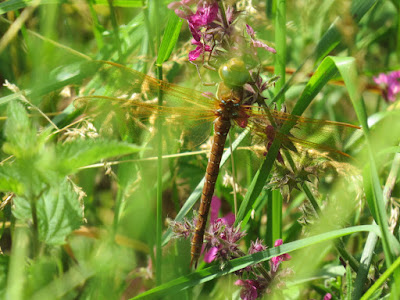Dave arrived and announced we should look out for Hairstreaks today as both common species had already been seen at Marsh Lane. Before long we were staring at some hedgerow Elms between two Oaks in the hope that the diminutive butterflies would flutter by, and indeed they did. Unfortunately they kept fluttering and without seeing one perched we were unable to confirm which they were.
A little further down the same hedge some Blackbirds were going ballistic at something. We hung around for some time before an Owl sp disappeared out of the back of the hedge. Was it going to be a frustrating morning?
Happily we had already had one success, as a large orange butterfly which perched in a hedge near Netherstead could be identified as a Silver-washed Fritillery, the first of the year.
 |
| Silver-washed Fritillery |
Until we reached the Flash Field there was not much to comment on bird-wise, save for a party of four recently fledged Green Woodpeckers at Netherstead. However, a juvenile Little Owl and anxiously calling parent bird set us up for a reasonably productive scan. The Shelducklings are all still alive and are close to fledging, two Little Ringed Plovers, a Snipe, two Lapwings, and at least seven Green Sandpipers hid behind the clumps of sedge, and a single female Teal flew in.
 |
| A preening Green Sandpiper |
 |
| Six-spot Burnet |
Dragonflies always get up a little later than butterflies, and by the time we were back at the dragonfly pools we had amassed a decent list. These included a Brown Hawker which allowed itself to be photographed in the grass near Stapenhill Wood, and a host of newly emerged Small Red-eyed Damselflies.
 |
| Brown Hawker |
 |
| Small Red-eyed Damselfly |
The whole place is a testament to what can be achieved when chemicals are not routinely sprayed everywhere.
No comments:
Post a Comment